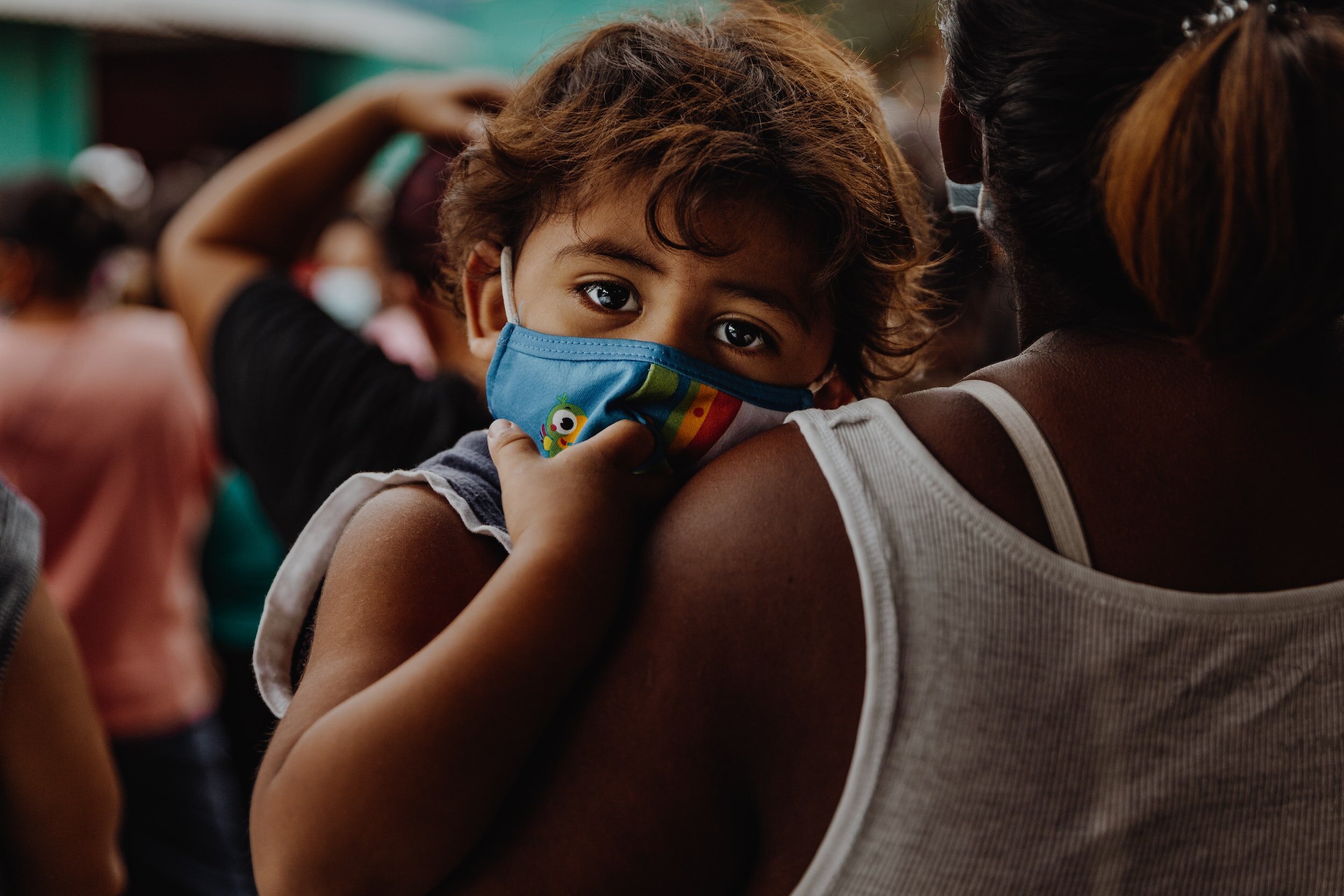Common Illnesses to Know
Many young parents are not accustomed to their children having common illnesses. It is important parents are aware and obtain knowledge on the various childhood illnesses, so they can effectively take care of and provide for their kid’s health needs.
Molluscum contagiosum
Molluscum contagiosum is a common skin condition caused by a virus that is spread through direct contact. The bumps usually appear as small, flesh-colored or white spots on the skin. The bumps can be found anywhere on the body, but they are often found in groups and are most common on the arms and legs.
There is no specific cure for molluscum contagiosum, but it often goes away on its own within 2 years. Your doctor may recommend using over-the-counter products like salicylic acid or liquid nitrogen to remove the bumps if they don’t go away on their own.
Fifth disease
When you get toddlers/kids involved in cooking there are so many teaching moments. There’s the hand and eye coordination that they need to learn. Fifth disease, also known as erythema infectiosum or slapped-cheek disease, is a common childhood illness that causes a rash. It’s caused by the parvovirus B19 virus, which you can get from an infected person’s body fluids or the environment. Fifth disease usually spreads via coughing and sneezing, especially in crowded places like schools. The first signs of fifth disease are a fever and sore throat which appear around three to five days after you’re infected with it.
Fifth disease symptoms include:
-
Skin rash on cheeks and/or arms (usually starts out as bright red spots before turning into pink bumps)
-
Swollen lymph nodes (you may feel them when pressing gently on your neck)
Impetigo
Impetigo is a common infection caused by bacteria. It’s most common in children, especially during the summer months. When you get impetigo, your skin will be red, swollen and crusted with clear blisters that ooze pus. You could also have fever or feel run down.
The blisters can be spread by touching the skin of an infected person—so don’t share bath water or towels with anyone who has impetigo! Treat it quickly with antibiotics—sometimes medical treatment is needed for weeks if there are complications such as abscesses under the skin (boils), which can be painful and require surgery to drain them.
Kawasaki disease
Kawasaki disease is a rare condition that causes inflammation of the blood vessels in the body. The condition can lead to heart problems, such as coronary artery aneurysms and pericarditis (inflammation of the sac around your heart).
It typically affects children under five years old. Kawasaki disease usually presents with fever, rash, and swollen lymph nodes in the neck. About 80% of cases show changes on an echocardiogram (an ultrasound image of your heart), but this doesn’t always happen.
Heat rash
If you’ve ever experienced heat rash, you know how uncomfortable it can be. Heat rash is a skin condition that occurs when sweat gets trapped under the skin and forms small bumps or blisters. It usually appears on the neck, chest, back, testicles and groin area in infants between six months and three years old. Heat rash usually goes away after about two days when your child cools down again
Hives
Hives are red, itchy bumps on the skin caused by an allergic reaction. Hives are not contagious and typically aren’t serious since they go away without treatment. They can be treated with an antihistamine such as Benadryl or Allegra. Be aware that hives can be a sign of a very serious allergic reaction, and if you suspect hives contact your physician right away. If there is any breathing trouble contact 911!
Pinworms
Pinworms are tiny, white worms that live in your child’s colon. They spread through contact with contaminated fingers.
Pinworm infection (pinworm infestation) is common among school-age children and can be treated with medication. Good hygiene habits can help prevent pinworms.
Although pinworms aren’t usually dangerous, they can cause uncomfortable symptoms such as itching or irritation around the anus and genitals, especially at night when your child is asleep.
Pertussis (whooping cough)
Pertussis, or whooping cough, is a bacterial infection that causes coughing attacks so severe they can stop you from breathing. It’s most common in infants and young children, but it can be serious for adults too.
The best way to protect yourself and your family is by getting vaccinated against pertussis. You should get vaccinated around age 11 or 12 (or as soon as possible if that’s past the recommended age), and then again every 10 years after that with a booster shot.
If you have symptoms of pertussis—a deep cough lasting more than 2 weeks—you’ll need
Hand, foot and mouth disease
Hand, foot and mouth disease (HFMD) is a common illness in children. It’s caused by a virus that spreads easily. The symptoms of HFMD are fever, sore throat, and blisters in the mouth or hands and feet. Most children recover from it without treatment.
In rare cases, hand-foot-and-mouth disease can cause serious complications such as encephalitis (inflammation of the brain), meningitis (inflammation of the membranes around your spinal cord) or paralysis. In these cases it’s important for your child to see a doctor as soon as possible for treatment.
Pharyngitis (strep throat)
If you have pharyngitis, your child has a sore throat, fever and swollen lymph nodes. The lymph nodes are collections of immune system cells found throughout the body. They’re especially prominent in the neck and groin.
If you think your child has strep throat, visit her doctor or a clinic to get tested for it. A doctor will swab the back of your child’s throat or tonsils to check for bacteria like group A streptococcus (strep).
Strep can be treated with antibiotics like penicillin or amoxicillin.
Ringworm (Tinea capitis)
Ringworm (tinea capitis) is a fungal infection that causes redness, itching, and flaking of the scalp. It usually affects children between ages 3 and 8 years old. Ringworm is caused by a fungus that can be spread from person to person by direct contact with an infected person or pet.
Fungal infections are common in children because their skin is more permeable than adults’ skin (more porous). This makes it easier for bacteria or other organisms to enter their bodies through cuts on the skin or abrasions caused by pressure against these areas—like when kids play outdoors in grassy areas where other kids may have used a sandbox recently!
Ringworm in children often begins as an area of dryness with slightly raised scales; this may be accompanied by redness around it too if there has been recent scratching due to itchiness after playing outside at school all day long without washing hands first before supper like mom told him too…
Roseola
What is roseola?
Roseola, or “sixth disease,” is caused by a virus that spreads easily from person to person. The fever begins when a child is about six months old, but it can start at any age.
Signs and symptoms of roseola include:
-
high fever (105 degrees F or higher) lasting three days to three weeks;
-
pink bumps (exanthema) on the trunk and arms that turn into small red dots (petechiae);
-
mild cough; and
-
red eyes with swelling.
Mononucleosis (Mono)
Mono, or infectious mononucleosis, is caused by the Epstein-Barr virus (EBV). This virus is a member of the herpes family and can cause lifelong infection in some people. Mono typically starts with a sore throat, fever and swollen lymph nodes in the neck. It may feel like you have a bad case of strep throat that lasts for months.
Mono can be spread through kissing or sharing food or drinks with someone who has mono. You can also get it if you’ve never had it before and have sex with someone who has it; however, this isn’t common since most people are vaccinated against EBV as teenagers (usually between 11 to 12 years old). The time it takes for symptoms to show up after exposure varies from person to person; some people get sick within two weeks while others don’t start feeling ill until they’re three months into their illness!
The best way to prevent getting mono is by avoiding close contact with anyone who has it—that means no kissing or sharing utensils! Be sure not only wash your hands frequently but also use hand sanitizer when needed since germs spread quickly during cold season when we’re all coughing around each other all day long—even at work!
Scarlet fever
Scarlet fever is a bacterial infection caused by Streptococcus pyogenes. It’s usually spread by direct contact with an infected person or touching objects that have been contaminated with their saliva or mucus. The symptoms of scarlet fever include a red rash, sore throat, and high fever. If your child has been diagnosed with strep throat or has recently come into contact with someone who has it—or if he’s exhibiting any of the other common symptoms listed below—you should call your pediatrician before giving him any over-the-counter medications such as acetaminophen for pain relief (which can be risky for very young infants).
Chickenpox
This common childhood illness is caused by the varicella-zoster virus, which is spread through direct contact with a person who has chickenpox. The virus causes blisters to appear on the skin, usually on the trunk and scalp. A few days after these blisters appear, they begin to crust over and scab over before falling off 10 days later. Some children may have a low-grade fever for up to three weeks during this time.
Whooping cough (pertussis)
Whooping cough is caused by Bordetella pertussis bacteria that cause severe coughing spells; these spells may last for several minutes at a time and result in vomiting or gagging as well as difficulty breathing between bouts of coughing. It’s important to note that even after symptoms are gone from one child, everyone else in the household should be vaccinated against whooping cough due to how contagious it can be for up to six weeks after the initial infection—and some people who appear healthy may still be carrying the disease without knowing it.
Conclusion
To sum up, there are many illnesses that children can get. There are different ways to treat them, and sometimes they go away on their own without any treatment at all. If your child has one of these illnesses, don’t panic! You should always consult with your doctor first before trying anything else.






